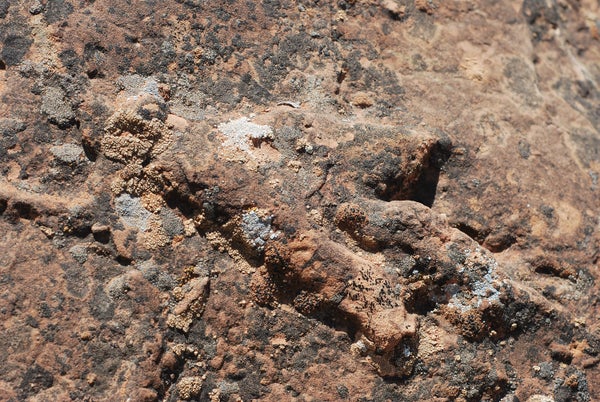This article was published in Scientific American’s former blog network and reflects the views of the author, not necessarily those of Scientific American
I moved to Utah for the dinosaurs. The state is so rich with rocks of the right age and type that, to trot out the old expression, we’ve only begun to scratch the surface of what’s out there. But not all exposures are equally kind to dinosaur hunters. While it’s difficult to walk around the Late Cretaceous exposures of Grand Staircase-Escalante National Monument and not find dinosaur bone, the dinosaurs of the Triassic Chinle Formation are extraordinarily elusive.
How the Chinle manifests is different from place to place. The famous formation contributes to the riches of Petrified Forest National Park in northern Arizona, for example. But in Utah, the Chinle can be a heartbreaker. There are tracks and traces galore, but bone is especially hard to find. And when you add in the fact that dinosaurs were still relatively small and rare parts of the fauna in the Triassic of North America, the expression “needle in a haystack” doesn’t even begin to describe the feeling of spending days or weeks looking for them without much but unidentifiable bone shards to show for it.
But there were dinosaurs around. There are at least some Triassic dinosaur tracks made by Coelophysis-like theropods (like the track in this post's photo, found at Dinosaur National Monument), and, while few and far between, dinosaurs have been uncovered in the Chinle Formation of neighboring states. So where are the bones? That’s the question Xavier Jenkins, John Foster, and Rob Gay have addressed in a new survey.
On supporting science journalism
If you're enjoying this article, consider supporting our award-winning journalism by subscribing. By purchasing a subscription you are helping to ensure the future of impactful stories about the discoveries and ideas shaping our world today.
The best record of Triassic dinosaurs in Utah, Jenkins and coauthors point out early in their paper, is likely to be a bonebed of small theropods found just outside Dinosaur National Monument. Given that these animals haven’t been formally published yet, we still have to wait on the details about their age and associations. But there is at least one other fossil that indicates theropods really were scurrying around Triassic Utah.
In 2005 Foster and volunteer Ray Bley collected a fossil that had fallen out of the Triassic rock of Corral Canyon, near Moab. It turned out to be a sacrum, or the fused part of the spine that adds support to the hips. And, the researchers conclude, it once fit into the body of a dinosaur.
Exactly what species of dinosaur the bones belonged to is a puzzle. The vertebrae don’t look like those of herrerasaurids – an archaic line of carnivorous dinosaurs present in Petrified Forest – and no one has found any definitive evidence of Triassic ornithischian dinosaurs. The sacral vertebrae best match a theropod, Jenkins and colleagues conclude, something akin to the iconic Coelophysis.
And that’s all for now. Which is a bit strange. Ghost Ranch, New Mexico is famous for the exceptional abundance and quality of its Chinle Formation dinosaurs. The record at Petrified Forest in Arizona isn’t nearly as good, but it’s still more rewarding than the Triassic rocks of Utah. So what was going on?
Maybe dinosaurs were rarer in Triassic Utah. Or perhaps the depositional environments weren’t as amenable to preservation. Then again, as the Saints and Sinners quarry outside Dinosaur National Monument has shown, sometimes it’s simply a matter of persistence until a fossil jackpot presents itself. After all, Utah is still relatively untrammeled ground compared to other spots in the Triassic west.
But experts are now under pressure. The current presidential administration’s plans to shrink Grand Staircase-Escalante and Bears Ears National Monuments has been met with frustration and fury among paleontologists because of what they threaten to steal from us. These places preserve some of the best Chinle exposures in Utah, and have already yielded excellent specimens of crocodile-like phytosaurs, strange poposaurids, and other Triassic animals. If there are Triassic dinosaur skeletons in Utah, they’re likely to be in the as-yet-little-explored reaches of these public lands. Finding Utah's earliest dinosaurs is now a race against time.
